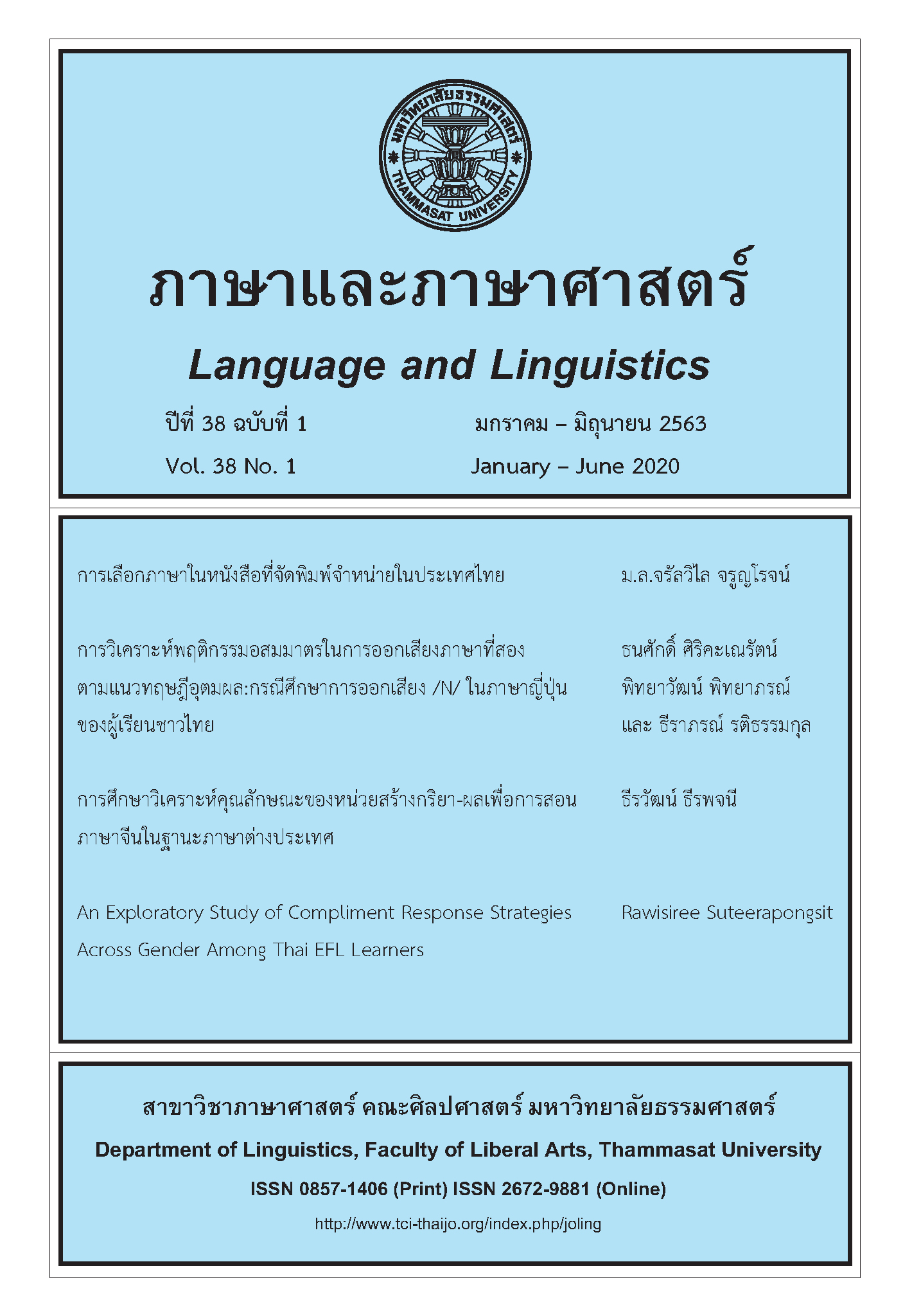การเลือกภาษาในหนังสือที่จัดพิมพ์จำหน่ายในประเทศไทย
Main Article Content
Abstract
The objectives of this study were to compare language choice on the covers and texts of books in terms of numbers of language and the patterns of co-occurrence. The data was collected from 1459 books published in Thailand.
Although 8 languages were found; Thai, English, Chinese, Japanese, Korean, German, French, Spanish, the majority of books and book cover are monolingual in Thai. The second and third prominent languages are English and Chinese. There are more multilingual books for children than for adults and more multilingual fiction books than multilingual non-fiction books. The patterns of language co-occurrence on book covers are more various than those inside books.
Article Details
บทความทุกบทความเป็นลิขสิทธิ์ของภาษาและภาษาศาสตร์
References
กระทรวงศึกษาธิการ. (2551). ตัวชี้วัดและสาระการเรียนรู้แกนกลางกลุ่มสาระการเรียนรู้ภาษาต่างประเทศ ตามหลักสูตรแกนกลางการศึกษาขั้นพื้นฐาน พุทธศักราช 2551. กรุงเทพฯ: ชุมนุมสหกรณ์การเกษตรแห่งประเทศไทย.
ราชบัณฑิตยสถาน. (2556). พจนานุกรมฉบับราชบัณฑิตยสถาน พ.ศ. 2554: เฉลิมพระเกียรติพระบาทสมเด็จพระเจ้าอยู่หัว เนื่องในโอกาสพระราชพิธีมหามงคลเฉลิมพระชนมพรรษา 7 รอบ 4 ธันวาคม 2554. กรุงเทพฯ: นานมีบุ๊คส์พับลิเคชั่นส์.
ภาวดี สายสุวรรณ. (2561). การเลือกภาษาในสื่อหนังสือพิมพ์และสื่อนิตยสารของไทย. วารสารมนุษยศาสตร์, 25(2), 232-257.
สถาบันทดสอบทางการศึกษาแห่งชาติ. (2561). รายงานค่าสถิติพื้นฐานการสอบ GAT/PAT ประจำ ปี2561 (กุมภาพันธ์ 2561). สืบค้นจาก https://www.niets.or.th/en/content/download/7465
สถาบันภาษาอังกฤษ สำนักงานคณะกรรมการการศึกษาขั้นพื้นฐาน. (2558). คู่มือการจัดการเรียนการสอนภาษาอังกฤษแนวใหม่ ตามกรอบมาตรฐานความสามารถทางภาษาอังกฤษที่เป็นสากล The Common European Framework of Reference for Languages (CEFR) ระดับมัธยมศึกษา. สืบค้นจาก http://english.obec.go.th/english/2013/index.php/th/2012-08-08-10-26-5/74-cefr
Bell, A. (2014). The guidebook to sociolinguistics. Malden, MA: Wiley Blackwell.
Carton, A. (2018). Role of book cover design in your book’s success. Retrieved from https://www.designhill.com/design-blog/role-of-book-cover-design-in-your-books-success/
Chesshire, J., & Moser, L. M. (1994). English as a cultural symbol: The case of advertisements in French-speaking Switzerland. Journal of Multilingual and Multicultural Development, 15(6), 451-469.
Eberhard, D. M., Simons, G. F., & Fennig, C. D. (Eds.). (2019). Ethnologue: Languages of the world (22nd ed.). Dallas, TX: SIL International. Retrieved from http://www.ethnologue.com
Fishman, J. A. (1965). Who speaks what language to whom and when? Linguistics, 1(2), 67-88.
Fishman, J. A. (1972). Domains and the relationship between micro- and macrosociolinguistics. In J. J. Gumperz & D. Hymes (Eds.), Directions in sociolinguistics: The ethnography of communication (pp. 435-453). New York, NY: Holt, Rinehart and Winston.
Goldstein, D. (2011). The use of English in Japanese advertising (Doctoral dissertation, Carnegie Mellon University). Retrieved from https://figshare.com/articles/The_Use_of_English_in_Japanese_Advertising/6686579/1
Holmes, J. (1992). An introduction to sociolinguistics. London, England: Longman.
MacGregor, L. (2003). The language of shop signs in Tokyo. English Today, 19(1), 18-23. https://doi.org/10.1017/S0266078403001020
Sangroong, P. (2015). English-Thai mixing on international women magazine’s covers and how this trend has developed and changed in the past six years: A case study of Thai edition of Marie Claire magazine (Master’s thesis). Chulalongkorn University, Bangkok.
Tuffelmire, D. (2017). Fiction vs. nonfiction writing styles. Retrieved from https://penandthepad.com/fiction-vs-nonfiction-writing-styles-3764.html


